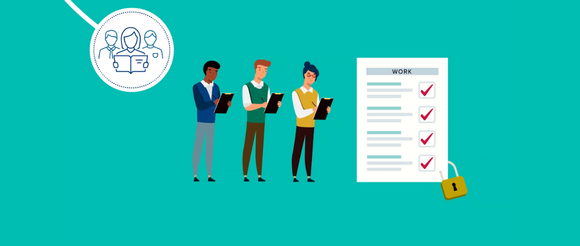Exams and assessments
The University has a 13-step process that is followed to ensure that your work is marked fairly and consistently. This applies to every piece of summative work that you submit.
To help explain this process, we have created a short animation and an infographic so that you can see what happens at each step.
13 steps for marking your assessments infographic
File
If you have any questions about this process or would like to find out more then please search MySurrey Help, which has lots of useful articles about many aspects of University life.
Our 13 steps for marking your assessments
- Your lecturer works out what assessment to set so you can show what you’ve learnt. A team of other Surrey academics monitor this. They make sure that the type, amount and weight or value are right. An ‘External Examiner’ (an academic from another university) might also review your lecturer’s approach to assessment as well at this stage.
- Your lecturer shares details of your assessment with you, including the nature and timing of your assessment and how it will be marked. They will include an outline of what they’re looking for by sharing their marking criteria to help you. This may be brought together in an assessment brief.
- Your lecturer answers questions in your seminar, discussion board or Q&A session. Please do make use of these opportunities and be aware of other sources of study support that we can offer you.
- You submit your assessment or you sit your exam.
- Assessment is normally marked and constructive feedback is provided within 3 semester weeks of the submission deadline. Remember not to count any non-semester, holiday weeks in this. (Exams follow a different timetable and slightly different process).
- A sample of work is then moderated or second marked thoroughly by a second lecturer to ensure fairness and consistency between assignments and modules.
- Some assessment, like final year dissertations, are marked twice, by two different lecturers. Sometimes they know the first mark. Sometimes they don’t and will meet to agree a mark together.
- Marking teams note and resolve any disagreements. Sometimes marks are raised or lowered to ensure fairness and consistency.
- Your provisional (non-exam) assessment marks and feedback become available on SurreyLearn. In 2020/21 a safety net will be applied to all eligible assessments in line with the safety net policy. This is designed to lessen the potential impact of the pandemic on assessment performance during the rest of the academic year.
- You cannot ask for your work to be remarked but external examiners review samples of work. They report to and attend a Board of Examiners along with your lecturers. This Board makes sure that marks are fair and consistent across modules and in line with other institutions. The Board then agrees the marks.
- Rarely they may find an unusual range and ask for an adjustment upwards or downwards. This is very carefully reviewed and approved by a high-level University committee called SPACE (Senate Progression and Conferment Executive).
- After the Board of Examiners, your marks become ‘agreed’, rather than ‘provisional’ on your student record.
- The University reflects on outcomes across all programmes.
Your marks journey is complete!
Don't forget that we have a dedicated online space for students, reps and staff to collectively raise, discuss and resolve academic and student life issues and feedback - MySurrey Voice.
Give us your feedback
https://www.instagram.com/tv/CHsiBezF1x-/?igshid=86z098kl7wd4
